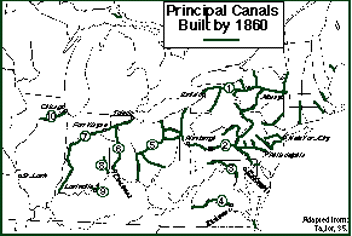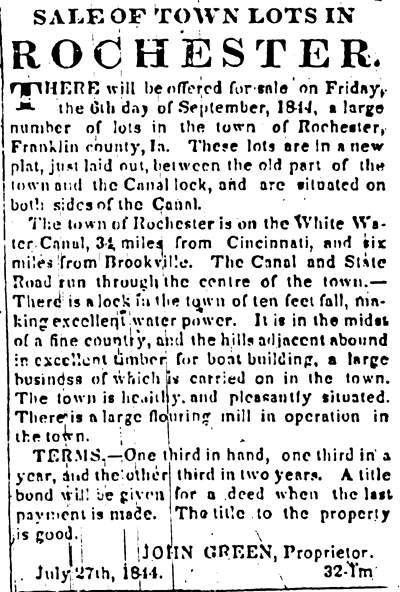Indiana's Canals
Most references to Indiana's canal era emphasize the failures. The canal era and canals, however, need to be studied as "a once vital dimension in the growth of the Old Northwest." Canals contributed "agricultural expansion and the export of agricultural surpluses, the import of eastern merchandise, and economic diversification towards manufacturing and commerce" (Shaw, 107, 105).
In Indiana,
the two . . . canals which were completed and in operation for some twenty to forty years - the Whitewater and the Wabash and Erie canals - had a positive impact upon their regions, served to stimulate agricultural and urban growth, and helped develop the towns, the millsites, the population, and the trade which the railroads of a later time dominated so completely. Gray, 129.
The 468-mile-long Wabash and Erie Canal was the longest canal in the country. It connected Lake Erie at Toledo with the Ohio River at Evansville in 1853. It was begun in 1832 at Fort Wayne, and crossed through Peru (1837), Lafayette (1843), and Terre Haute (1849). It cost approximately $8,200,000.
After 1841, Indiana could not pay the interest on its canal and internal improvements bonds - many of which had been purchased by people in foreign countries. Work on the Wabash and Erie Canal continued because of more grants from the federal government of land to sell. Bondholders, under the leadership of attorney Charles Butler, supported continued operation and completion of the canal under trustees to recoup some of their money. There were periods when the canal was profitable. Floods, vandalism, and railroads (which were built along the canal routes) finally caused closure of the canal in 1874.
The Whitewater Canal in the Whitewater Valley of southeastern Indiana eventually extended from Cincinnati, Ohio to Hagerstown, Indiana. The canal was proposed in 1825. Progress was first made with the incorporation of the Whitewater Canal Company in 1826. Much of the canal was completed through the efforts of private citizens who organized into construction companies. Explore the timeline in this issue for events of its progress.
After the Whitewater Canal ceased operations in 1865,
. . . it continued to serve a number of mills and, on the section between Milton and Connersville, to develop hydro-electric power for almost a century thereafter. . . . the canal had a long history and a long term of spasmodic usefulness. . . . Among the earliest in Indiana, they [canal supporters of the Whitewater Valley] were also foremost in determination, in tenacity, and in blind courage. Fatout, 156.
The map below demonstrates that canals were an important step in the process of connecting the areas of the United States. As Shaw notes, "the cost of transportation fell dramatically from more than ten cents per ton mile to as little as a cent; a canal network of 3,326 miles was built by 1840 at a cost of more than $125 million, and the way was opened for the railroad to follow" (100).

Indiana's late entry into the canal era, in hindsight, doomed its efforts. New York, Pennsylvania, and Ohio had built over 1,000 total miles of successful canals by 1830. In 1830, only Pennsylvania (seventy miles) and Massachusetts (three miles) had built railroads. By 1840 in all states, the complete mileage of canals was nearly equal to the complete miles of railroads. By 1850, the complete railroad miles were roughly two and one-half times the canals. By 1860, the complete railroad miles were roughly eight times the canals. The canal era had given way to railroads (Taylor, 79-80).
Canals were expensive. Most were possible only with governmental support from states. Many were possible only because the U.S. Congress granted public land that could be sold to support construction. The concept of such public support for internal improvements has continued to the present day, for example, with the interstate highway system.

Rochester, later Cedar Grove, Franklin County, is typical of towns that prospered or were founded because of canal construction. Carefully read the advertisement. What other transportation advantage did the town offer? What were some of the canal-related businesses?
Brookville Indiana American, August 2, 1844.
